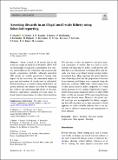Files in this item
Assessing discards in an illegal small-scale fishery using fisher-led reporting
Item metadata
| dc.contributor.author | Mendo, Tania | |
| dc.contributor.author | Mendo, J. | |
| dc.contributor.author | Ransijn, Janneke | |
| dc.contributor.author | Gomez, I. | |
| dc.contributor.author | Gil-Kodaka, P. | |
| dc.contributor.author | Fernández, J. | |
| dc.contributor.author | Delgado, R. | |
| dc.contributor.author | Travezaño, M. | |
| dc.contributor.author | Arroyo, R. | |
| dc.contributor.author | Loza, K. | |
| dc.contributor.author | McCann, Paddy | |
| dc.contributor.author | Crowe, S. | |
| dc.contributor.author | Jones, E. | |
| dc.contributor.author | James, Mark Andrew | |
| dc.date.accessioned | 2022-03-30T14:30:19Z | |
| dc.date.available | 2022-03-30T14:30:19Z | |
| dc.date.issued | 2022-03-28 | |
| dc.identifier | 278369923 | |
| dc.identifier | 7ec04050-1f42-4dfd-a952-494b29f1c224 | |
| dc.identifier | 000773818400002 | |
| dc.identifier | 85127254748 | |
| dc.identifier.citation | Mendo , T , Mendo , J , Ransijn , J , Gomez , I , Gil-Kodaka , P , Fernández , J , Delgado , R , Travezaño , M , Arroyo , R , Loza , K , McCann , P , Crowe , S , Jones , E & James , M A 2022 , ' Assessing discards in an illegal small-scale fishery using fisher-led reporting ' , Reviews in Fish Biology and Fisheries , vol. Online First . https://doi.org/10.1007/s11160-022-09708-9 | en |
| dc.identifier.issn | 0960-3166 | |
| dc.identifier.uri | https://hdl.handle.net/10023/25126 | |
| dc.description | Funding: Newton Fund (IL 2018-Grant Agreement 414695818 James PER), Fondo Nacional de Desarrollo Científico, Tecnológico y de Innovación Tecnológica (PE) (FONDECYT 2018-222). | en |
| dc.description.abstract | About a third of all marine fish in the world are caught in Small-Scale Fisheries (SSF). SSF are increasingly recognised as essential for food security and livelihoods for vulnerable and economically fragile communities globally. Although individual SSF vessels are usually perceived as having little impact on the ecosystem, the cumulative impact of gear type and number of vessels may be substantial. Bottom trawling is a common fishing method that can greatly influence the marine ecosystem by damaging the seafloor and generating high levels of discards. However, appropriate sampling coverage using on-board observer programmes to collect these data from SSF are rare, as they are expensive and pose logistical constraints. A mobile App was used to assess whether self-reporting by fishers could provide reliable fine-scale information on fishing effort and discards over time in an illegal shrimp trawling fishery in northern Peru. Maps depicting the spatial distribution of trawling effort and the proportion of discards from observers and fishers were compared using the Similarity in Means (SIM) Index, which ranges from 0 when spatial patterns differ completely to 1 when spatial patterns are very similar. High levels of agreement between spatio-temporal patterns of effort (SIM Index = 0.81) and discards (0.96) were found between fisher and observer maps. Moreover, far greater spatial coverage was accomplished by fishers, suggesting that self-reporting via an App represents a useful approach to collect reliable fisheries data as an initial step for effective monitoring and management of these fisheries. | |
| dc.format.extent | 12 | |
| dc.format.extent | 1288417 | |
| dc.language.iso | eng | |
| dc.relation.ispartof | Reviews in Fish Biology and Fisheries | en |
| dc.subject | Effort | en |
| dc.subject | Tracking | en |
| dc.subject | Bycatch | en |
| dc.subject | Mobile application | en |
| dc.subject | Blue agenda | en |
| dc.subject | Trawling | en |
| dc.subject | QA75 Electronic computers. Computer science | en |
| dc.subject | GC Oceanography | en |
| dc.subject | SH Aquaculture. Fisheries. Angling | en |
| dc.subject | SDG 2 - Zero Hunger | en |
| dc.subject | SDG 14 - Life Below Water | en |
| dc.subject.lcc | QA75 | en |
| dc.subject.lcc | GC | en |
| dc.subject.lcc | SH | en |
| dc.title | Assessing discards in an illegal small-scale fishery using fisher-led reporting | en |
| dc.type | Journal item | en |
| dc.contributor.institution | University of St Andrews. Coastal Resources Management Group | en |
| dc.contributor.institution | University of St Andrews. School of Biology | en |
| dc.contributor.institution | University of St Andrews. Scottish Oceans Institute | en |
| dc.contributor.institution | University of St Andrews. Sea Mammal Research Unit | en |
| dc.contributor.institution | University of St Andrews. University of St Andrews | en |
| dc.contributor.institution | University of St Andrews. Marine Alliance for Science & Technology Scotland | en |
| dc.identifier.doi | 10.1007/s11160-022-09708-9 | |
| dc.description.status | Peer reviewed | en |
This item appears in the following Collection(s)
Items in the St Andrews Research Repository are protected by copyright, with all rights reserved, unless otherwise indicated.

